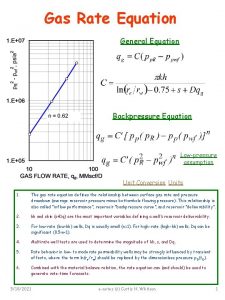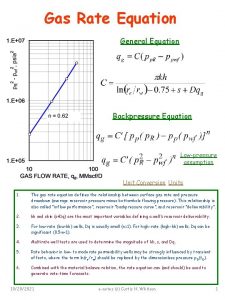Photosynthesis Photosynthesis The Photosynthesis Equation 6 CO 2










- Slides: 10

Photosynthesis

Photosynthesis

The Photosynthesis Equation 6 CO 2 + 6 H 2 O + sunlight Carbon Dioxide + Water + Light Energy C 6 H 12 O 6 + 6 O 2 sugar + oxygen What is it? • Plants use energy from the sun to convert carbon dioxide and water into oxygen and sugars. • Plants use some of the sugar food. The cells break down the sugar molecules to release the energy they contain. Where does it happen? • In chloroplasts: Some sugar molecules are converted into other compounds like cellulose. Other sugar molecules may be stored for later use. • When you eat food made by plants, like carrots or potatoes, you are eating the plant's stored energy. Which organisms use it? • Plants (land or water) and phytoplankton What do we call organisms that make their own food? • Producers or “autotrophs”

The Two Stages of Photosynthesis Stage 1: Capturing the Sun's Energy What happens in stage 1? • Chloroplasts are green organelles inside plant cells. • The green color comes from pigments, colored chemical compounds that absorb light. • The main photosynthetic pigment in chloroplasts is chlorophyll. • Chlorophyll captures light energy and uses it to power the second stage of photosynthesis.

The Two Stages of Photosynthesis Stage 2: Using Energy to Make Food What happens in stage 2? • Roots absorb the water and stomata absorbs the carbon dioxide. • Stomata are small openings in the underside of leaves. • water and carbon dioxide in the leaves moves into the chloroplasts. • Chloroplasts use the water and carbon dioxide and with the energy from the 1 st stage, undergo a series of chemical reactions. • The reactions produce products: – sugar that has 6 carbon atoms. Sugars are a type of carbohydrate. Cells can use the energy in sugar to carry out important cell functions. – oxygen, which leaves the leaf through the stomata. • Almost all the oxygen in the Earth's atmosphere is produced through photosynthesis.

Cellular Respiration

C 6 H 12 O 6 + 6 O 2 sugar + oxygen Cellular Respiration 6 CO 2 + 6 H 2 O + Energy (ATP) Carbon Dioxide + Water + Chemical Energy What is it? • cells use oxygen to release energy stored in sugars, like glucose Where does it happen? • in organelles called mitochondria Which organisms use it? • Plant AND animal cells both have mitochondria

Two Stages of Cellular Respiration Stage 1: Happens where? in the Cytoplasm What happens in stage 1? • Glucose in the cytoplasm is broken down into smaller molecules, releasing energy • Smaller molecules move into the mitochondria

Two Stages of Cellular Respiration Stage 2: Happens where? in the Mitochondria What happens in stage 2? • Smaller molecules (glucose break-down products) move into the mitochondria. • Oxygen enters the cell & goes into the mitochondria. • As the smaller molecules are broken down even further, hydrogen is released in a way that allows cells to capture energy in a usable form. The hydrogen combines with oxygen to make water. • Products: energy, carbon dioxide, and water. • Some of the energy is transferred to other molecules, which carry the energy where it is needed for the activities of the cell. • Remaining energy is released as heat. • Carbon dioxide formed during cellular respiration is released by the cell.




















